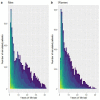COVID-19 - exploring the implications of long-term condition type and extent of multimorbidity on years of life lost: a modelling study
- PMID: 33709037
- PMCID: PMC7927210
- DOI: 10.12688/wellcomeopenres.15849.3
COVID-19 - exploring the implications of long-term condition type and extent of multimorbidity on years of life lost: a modelling study
Abstract
Background: COVID-19 is responsible for increasing deaths globally. As most people dying with COVID-19 are older with underlying long-term conditions (LTCs), some speculate that YLL are low. We aim to estimate YLL attributable to COVID-19, before and after adjustment for number/type of LTCs, using the limited data available early in the pandemic. Methods: We first estimated YLL from COVID-19 using WHO life tables, based on published age/sex data from COVID-19 deaths in Italy. We then used aggregate data on number/type of LTCs in a Bayesian model to estimate likely combinations of LTCs among people dying with COVID-19. We used routine UK healthcare data from Scotland and Wales to estimate life expectancy based on age/sex/these combinations of LTCs using Gompertz models from which we then estimate YLL. Results: Using the standard WHO life tables, YLL per COVID-19 death was 14 for men and 12 for women. After adjustment for number and type of LTCs, the mean YLL was slightly lower, but remained high (11.6 and 9.4 years for men and women, respectively). The number and type of LTCs led to wide variability in the estimated YLL at a given age (e.g. at ≥80 years, YLL was >10 years for people with 0 LTCs, and <3 years for people with ≥6). Conclusions: Deaths from COVID-19 represent a substantial burden in terms of per-person YLL, more than a decade, even after adjusting for the typical number and type of LTCs found in people dying of COVID-19. The extent of multimorbidity heavily influences the estimated YLL at a given age. More comprehensive and standardised collection of data (including LTC type, severity, and potential confounders such as socioeconomic-deprivation and care-home status) is needed to optimise YLL estimates for specific populations, and to understand the global burden of COVID-19, and guide policy-making and interventions.
Keywords: COVID-19; Coronavirus; Epidemiology; Multimorbidity; noncommunicable diseases.
Copyright: © 2021 Hanlon P et al.
Conflict of interest statement
No competing interests were disclosed.
Figures





References
-
- World Health Organisation: Coronavirus disease 2019 (COVID-19) Situation Report – 77.2020. Reference Source
-
- Public Health England: Guidance on social distancing for everyone in the UK.2020. Reference Source
Grants and funding
LinkOut - more resources
Full Text Sources
Other Literature Sources
Research Materials

